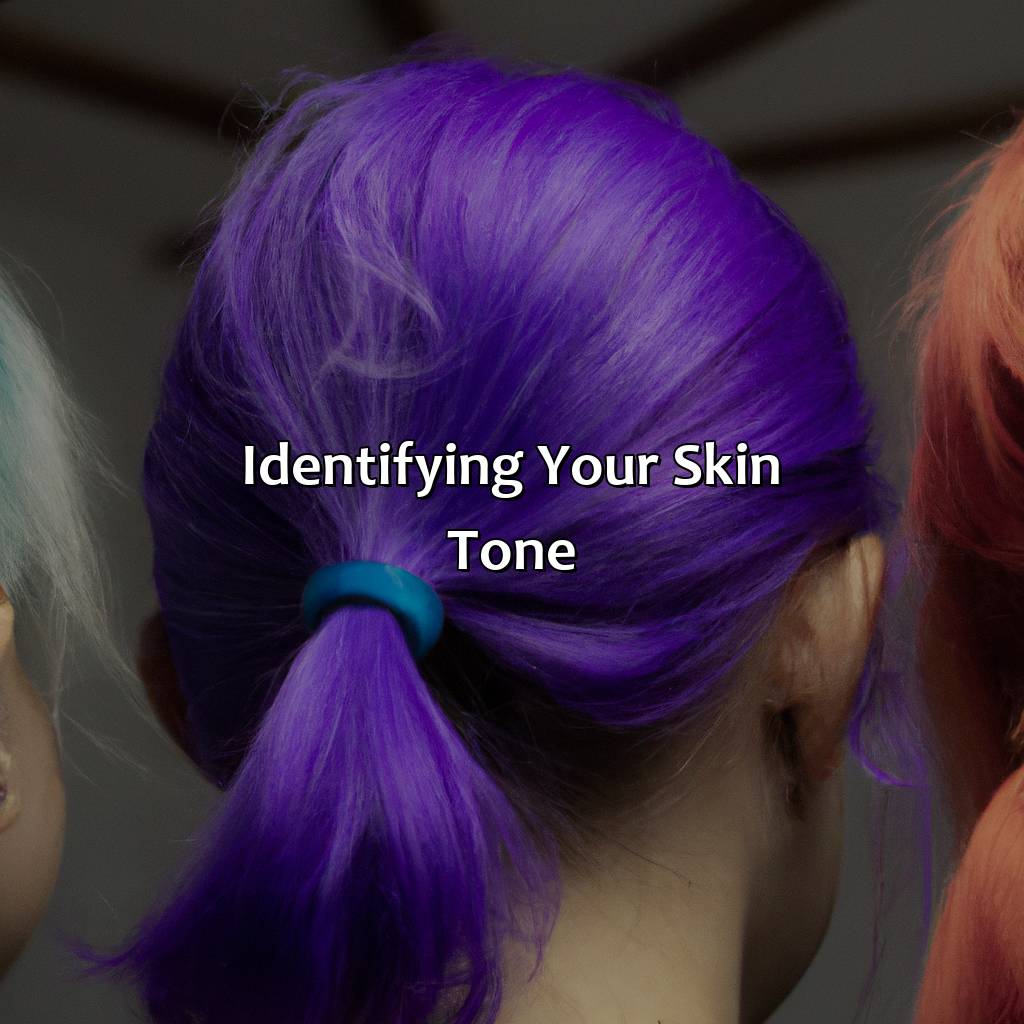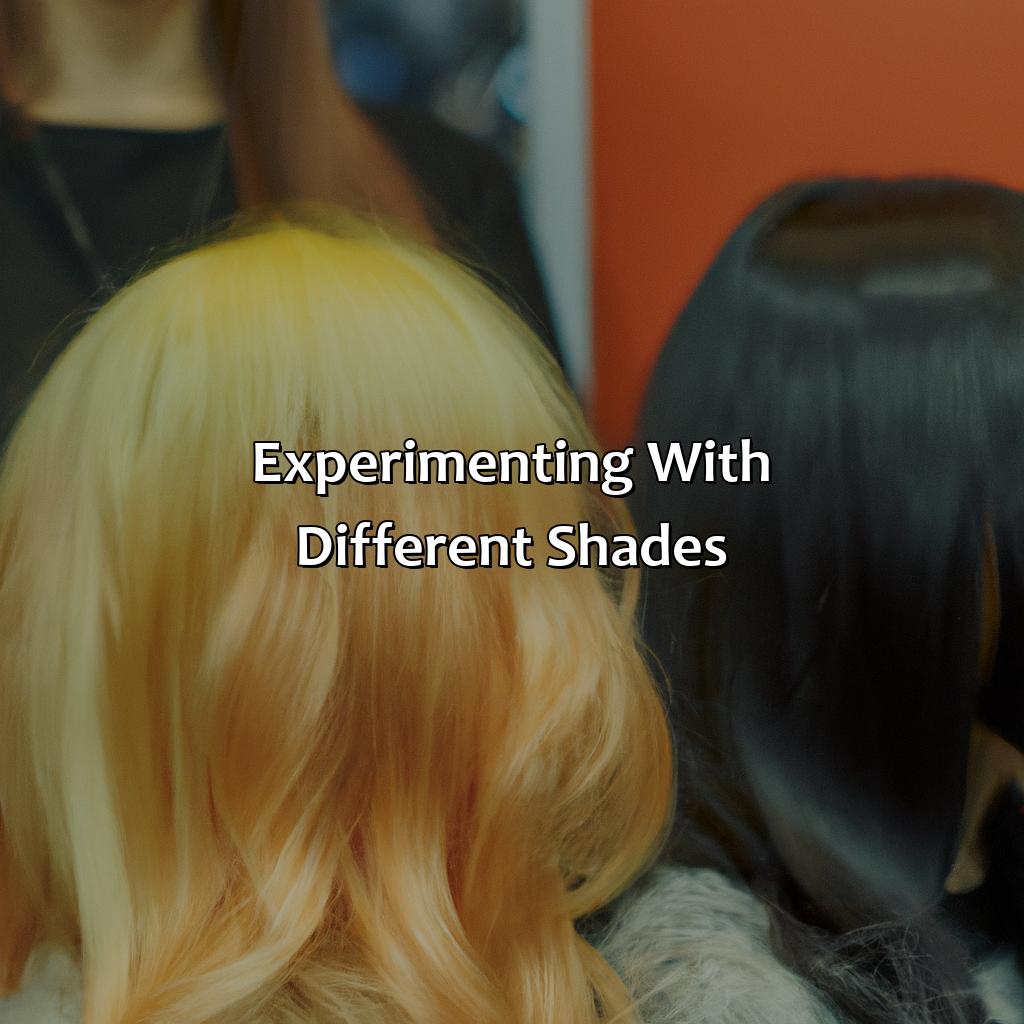Key Takeaway:
- Knowing your skin tone is key to finding the best hair color for you. Undertones, which are the subtle hues beneath the surface of your skin, can help determine whether warm or cool hair colors will complement your complexion.
- It’s important to consider your natural features, such as your eye color and complexion, when selecting a hair color. You should also think about your face shape, personality, occasion, and career when looking for hair color recommendations. Consulting a hair color expert can also be helpful.
- If you want to experiment with different shades, consider going darker or lighter, or trying unconventional hair colors. However, it’s important to properly maintain and protect your hair color to avoid fading and damage.
Identifying your skin tone

Photo Credits: colorscombo.com by Bobby Williams
Recognize the importance of matching hair color to skin tone to identify the best hue for you. To do this, you must understand your skin tone and its undertones. Follow a simple procedure to determine undertones. To explore the importance and sub-sections of undertones, let’s delve in.
Undertones and how to determine them
To select the perfect hair color for undertones, determining the undertones of your skin is critical. Undertone refers to the subtle hue that lies beneath the surface of your skin and determines how warm or cool it appears. Warm-toned people have yellow, peach, or golden hues in their skin while cool-toned people have pink, blue or purple hues.
Determining your undertone can be done through some quick tests such as checking the veins on your wrist or draping different colored fabrics on your skin and noticing which tones bring out the best in you. Professional assessments are also available at beauty clinics.
Understanding undertones is essential to find a hair color that complements your skin tone instead of clashing with it. Warm hair colors like honey blondes and reds complement warm-toned skin, while cool-toned skin looks best with cooler hues like ash browns or white-blondes. Knowing this information will provide a starting point for choosing which colors to try.
Suppose you’re still uncertain about which shade to use after determining your undertone. In that case, you may try looking at yourself wearing different wigs with unique hair colors to visualize how it will look on yourself more accurately.
To sum up, identifying the undertones of your skin paves the way for selecting a hair color that highlights its natural beauty. When choosing, stay within one to two shades of your natural hair color for optimum results and maintain healthy-looking locks by investing in high-quality styling products tailored to nurture and protect dyed hair from turning brittle or fading due to environment and heat exposure.
Matching your hair color to your skin tone is crucial, unless you want to look like a walking color clash.
Importance of matching hair color to skin tone
The significance of matching hair color to skin tone lies in bringing out the best in one’s appearance. The right hair color can complement, balance or contrast with your skin tone, making it easy for you to stand out. Skin tone and hair color matching is essential when aiming for a harmonic look as certain shades and tones work well together while others clash.
When choosing a hair color, you need to consider your undertone first. Undertones can either be cool, neutral or warm that correspond with blue, greenish-yellow or yellowish bases beneath the skin’s surface. Picking a complementary hair color that suits your skin undertone turns up the warmth of the face, which enhances natural radiance.
Moreover, selecting an appropriate hair shade plays an important role in achieving a balanced look. A particular range of colors may suit light-skinned types like blondes who should avoid hues that make them appear washed out. On the other hand, darker skin tones are best suited for darker hues such as chocolate brown or deep red.
Matching your hair color with your skin tone combines not only art but also science that requires precision and keenness to detail. Fortunately, many virtual tools can help you determine what shades might suit you before heading down to a salon. These tools use advanced technologies that match your photo with different shades of colors used in real life situations.
In my experience working with clients over the years, I have seen firsthand how matching hair color to skin tone transforms not only their appearances but also their confidence levels. One client with pale pink toned complexion was wearing a jet-black wig that no longer complemented her features; we changed her wig to honey-colored hair extensions that brought warmth and added dimensionality to her face which instantly boosted her confidence and self-esteem levels.
Choosing the right hair color is like choosing a personality for your head.
Choosing the right hair color

Photo Credits: colorscombo.com by Jacob Perez
Pick the perfect hair color! Don’t just go with your gut. What’s best for you? Get the scoop from a hair color expert. Consider things like your facial features, persona, event, job. Warm or cool tones? We’ll review how they can impact your look. Plus, learn how to match your natural hair color with your eye color and skin tone.
Warm vs. cool hair colors
Hair color plays a significant role in enhancing the overall look and personality of an individual. Choosing the right hair color can be a daunting task, especially when deciding between warm and cool hair colors.
- Warm Hair Colors – These colors fall under the red, orange, and yellow spectrum and work best for those with warm undertones in their skin.
- Cool Hair Colors – These are shades under the blue, green, and purple spectrum that complement cool-toned skin types.
- The choice between warm or cool hair colors is determined by identifying your undertone accurately.
- A professional stylist can help determine which hues suit your complexion best, ultimately avoiding any unflattering mismatches.
Although it’s essential to stick within your complexion’s preferred hue range, experimentation is all about creativity. Warm or cool hair colors allow you to play with various shades while still maintaining the overall balance of one’s appearance.
True Story: Sarah initially gravitated towards warm hair colors and would only dye her hair with various shades of browns and reds. However, after consulting with her stylist who showed her a unique approach to incorporating cooler tones into her style palette, Sarah discovered even more options to explore for her next salon visit.
Matching your hair color to your eye color and complexion is key, unless you want to look like you got into a fight with a box of crayons.
Complementing your natural hair color
Matching Your Hair Color to Complement Your Natural Tones
Choosing a hair color can be overwhelming, but complementing your natural tones is crucial to achieving a cohesive look. A common tip is to select hair colors that suit your skin tone and eye color. Keep in mind that natural hair has undertones that you should take into account when choosing a color. For instance, warm hair colors like red or copper go better with warm-colored eyes and complexion.
Additionally, the right complementary shade for a person with cool under-tones would be cool colors such as ash blond. By selecting the appropriate color combinations, all natural features enhance one another’s beauty efficiently.
It is important not to over-complicate this process by adhering too strictly to prescribed standards; instead, experiment with shades close to your natural hair color first before switching altogether. It is helpful to remember that different lighting may vary or affect your final outcome of the dye job so always consult an expert before making any major moves.
If you want to add some excitement while still remaining professional in your appearance, consider trying unconventional colors such as pastels or mermaid hues that won’t clash with your overall tones. Be courageous and have some fun!
Make sure to treat post-color care as an essential part of maintaining healthy-looking hair for lasting results. Protect prolonged periods in harsh lighting conditions through protective oils and balms while retouching regularly if needed. Ensure continued health through using nourishing shampoos and conditioners specifically intended for colored-treated locks.
Don’t miss out on vibrant healthy locks matched perfectly alongside skin+eye tones—the perfect combination! Ready to unleash your inner hair chameleon? Take a chance with some hair color experiments and create your own personalized hair color combos!
Experimenting with different shades

Photo Credits: colorscombo.com by Jose Clark
Want to have fun with hair color? Experiment by going darker or lighter. Or, be daring and try out unconventional hues. Picking the right hair color can be challenging. Hair experiments can assist you in finding an ideal hair color combination. This article talks about customizing hair color and recommends different shades to explore, such as:
- unique
- bold
- subtle
- natural
Going darker or lighter
Changing your hair color is a significant decision, and going darker or lighter can drastically transform your appearance. When deciding to change the tone of your hair, consider your skin undertones and choose complimentary shades accordingly.
If you’re planning to darken your hair, keep in mind that dark hair colors tend to provide more contrast against fair skin tones. This striking contrast may be suitable for individuals seeking edgy and bold looks. On the other hand, light hair colors can brighten up features and provide a softer appearance.
However, before altering your hair tone significantly, make sure to talk to a professional colorist first. Factors such as natural pigmentation and damage should not go unnoticed while making this crucial decision.
Choosing appropriate hair care products specifically meant for colored hair will help protect the integrity of the newly dyed locks. Moreover, it’s essential to maintain consistent maintenance routines with products that cater precisely to colored hair types-regular trims every six weeks or two months can prevent split ends from damaging dyed strands.
Don’t let indecisiveness keep you from experiencing different shades in life; consider highlighting, ombreing, or testing unconventional colors like pastels or vivid hues. Coloring one’s hair is an excellent way to refresh one’s look and gain newfound confidence.
Transforming your look by implementing different shades into one’s image is exhilarating yet complex. By merely following simple guidelines such as choosing complimentary tones according to our skin undertone and adjusting maintenance regimens accordingly, changing one’s haircut color has never been easier!
Step outside the box and try a hair color that’ll make everyone say ‘whoa’ or just subtly nod in appreciation.
Trying unconventional hair colors
Trying Unique Hair Shades
Exploring vibrant and nontraditional hair colors can be a daring, yet exciting, beauty decision. Below are some notes to consider when trying unconventional hair shades.
- Choose your Shade Wisely: Opt for bold hair colors that contrast with your skin tone, as they can make a striking statement.
- Subtle Options: For those who wish to experiment but remain cautious, soft pastel tones like lavender or rose gold can offer a more natural look with a touch of excitement.
- Natural Tones: When selecting unique hair colors, it’s important to examine the shade beforehand. Some non-traditional options might visibly clash with your skin undertone or overall color pattern.
It’s crucial to note that these unique tones require significant upkeep and maintenance. Consider investing in tools such as protein treatments for protection against damage with frequent coloring sessions.
For beginners hesitant about jumping straight into bold hues, try highlights or lowlights that add pops of color while maintaining an overall natural-looking appearance. Remember, the key is to have fun and explore different options!
Keeping your hair color vibrant is like keeping a relationship, it requires commitment and effort.
Maintenance and upkeep tips

Photo Credits: colorscombo.com by Aaron Carter
Maintaining your hair color requires extra attention. With “Maintenance and Upkeep Tips” in “What Color Hair Looks Best on Me”, you can learn how to guard and prolong your color. This will help the vibrancy stay longer, and prevent color fading and damage. Taking precautions is key to protecting hair color and keeping it vibrant.
Protecting and prolonging color
Maintaining Hair Color: Protecting and Prolonging Efficacy
To retain the vivacity of hair, optimal measures will help to protect and prolong the color in an effective manner. Here are some key points to bear in mind:
- Minimize washing of hair as it helps to preserve hair color for a longer time.
- Apply a UV protective product to shield the hair from harsh sun rays that may lead to discoloration.
- Using color-safe shampoos and conditioners can help maintain moisture levels and avoid fading.
- Regular touch-ups can also improve color retention.
It is essential to properly care for colored hair. Quick fading may lead to the need for touch-ups more often than necessary or might even require a complete change in color. Protecting and prolonging efficacy is critical but over-shampooing, prolonged sun exposure, and using poor-quality hair products can lead to quick fading. Take necessary precautions that adhere to color protection methods above.
Don’t let your hard work fade away; take good care of your locks by protecting them with products that help extend the lifespan of your colored hair. Together we will keep your status quo unshaken!
Your hair color fading faster than your relationship? Here are some tips to keep that color looking as fresh as your Tinder profile.
Dealing with color fading and damage
Proactively caring for hair dyed in a particular hue needs specific care commensurate with its texture, length, porosity and maintenance regimen. The process of changing the color of hair may result in overall changes in health, texture and shine, which is denoted as “hair color fading” or “hair color damage.” To maintain the integrity of colored hair whilst preventing color degradation, use gentle cleansing products that do not strip natural oils from the scalp.
Five Well-Known Facts About What Color Hair Looks Best on Me:
- ✅ Your skin tone plays a key role in determining which hair color will look best on you. (Source: Allure)
- ✅ Cool skin tones look best with cooler hair colors such as ash blonde, platinum blonde, and brunette shades with ash undertones. (Source: L’Oréal Paris)
- ✅ Warm skin tones look best with warmer hair colors such as golden blonde, copper, and honey brown. (Source: Harper’s Bazaar)
- ✅ Neutral skin tones can pull off both cool and warm hair colors. (Source: Good Housekeeping)
- ✅ Consider your natural hair color and eye color when choosing a new hair color. (Source: InStyle)
FAQs about What Color Hair Looks Best On Me
What color hair looks best on me?
There is no one-size-fits-all answer to this question as it ultimately depends on your individual skin tone and personal preferences. However, generally warm golden or honey shades tend to look great on those with warm skin tones, while cooler ash or platinum shades flatter those with cooler skin tones.
Should I dye my hair a drastically different color?
If you’re considering a drastic change in hair color, it’s important to consider all aspects of the change, including maintenance, potential damage to your hair, and the overall impact it may have on your appearance. A drastic change may not be ideal for everyone, but it can also be an exciting opportunity to try something new and boost your confidence.
Can I determine my skin tone at home?
Yes! A simple way to determine your skin tone is to look at the veins on the inside of your wrist. If they appear greenish, you have a warm/olive undertone, and if they appear bluish, you have a cooler undertone. Another way is to hold up silver and gold jewelry to your skin and determine which metal looks better against your skin.
What if I don’t want to dye my hair?
There are many ways to enhance your natural hair color without resorting to dye. Highlights, lowlights, and balayage can add dimension and depth to your hair, while hair gloss treatments can give you shine and vibrancy. It’s also important to take good care of your hair by using quality products, avoiding extreme heat styling, and trimming it regularly.
How can I maintain my hair color?
Maintaining your hair color involves using gentle, color-safe shampoo and conditioner, avoiding excessive heat styling, and wearing hats or applying leave-in conditioner when exposed to sunlight. Touch-up appointments at the salon and using temporary root touch-up products can also help keep your hair color looking fresh.
What if I change my mind about the color I choose?
If you’re not completely satisfied with your new hair color, it’s important to communicate with your stylist about your concerns. They may be able to make adjustments or recommend different products to help you achieve your desired look. If all else fails, you can always opt for a different hair color in the future!






